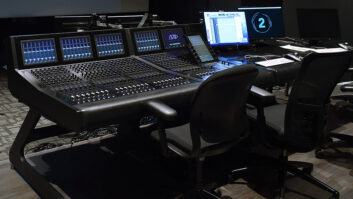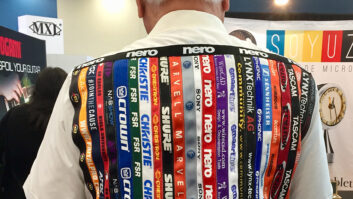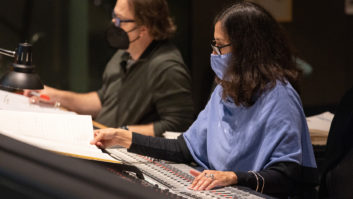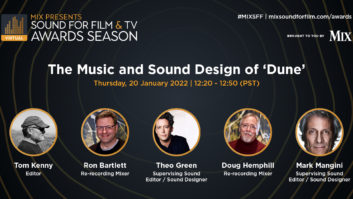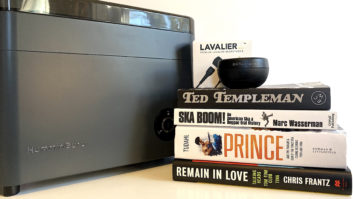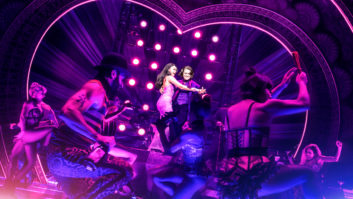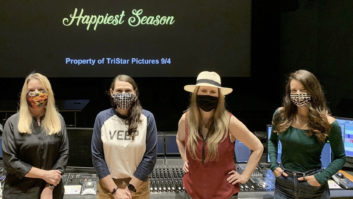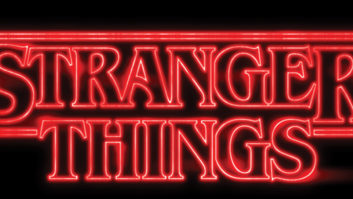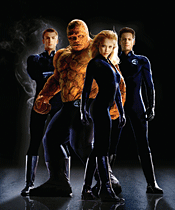
photo: Nels Israelson TM and ©2004 Twentieth Century Fox. All rights reserved.
“I can play the trumpet, you know,” says the Human Torch. Actor Chris Evans, who plays the fiery member of Marvel’s Fantastic Four (20th Century-Fox), has dropped into Fox’s Newman Scoring Stage from a nearby looping session to hear John Ottman’s score recording. But the real action is out on the stage, where the orchestra is in its last of five days of recording.
Ottman is finishing his second Marvel film (the first being X2: X-Men United) before dashing off to Australia to begin his next comic book adventure, Superman Returns, for which he will act as both composer and film editor. It’s clear who the real superhero in the room is.
“This is a score-heavy movie,” explains music supervisor Dave Jordan. “There’s 90 minutes of score and eight or nine songs. There’s nonstop music.”
Ottman is recording his 35 cues for the film at Newman, his stage of choice. “It’s like a morphing together of the best of Sony and Todd-AO into one,” he says. “It’s not too dead, it’s not too live. After I recorded my first score here — for Eight Legged Freaks — I never wanted to go anywhere else.”
Mixer Casey Stone (L) and composer John Ottman “hard” at work on the score for Fantastic Four
photo: Rudy Koppl
He also brings another part of his success story: scoring mixer Casey Stone (www.caseystone.com), who has worked with the composer since the 1998 Halloween H20. Stone is recording to Pro Tools|HD — running at 96 kHz, 24-bit, on a 64-input/80-output rig — on this day, which was rented from DMT Rentals. “Our Pro Tools operator for the majority of the show is Larry Mah, who has his own rig. But we’re in a hurry to get started on our mix tomorrow at Signet Sound, so we sent Larry over there to get set up.” Stone, instead, took advantage of the skills of freelance Pro Tools operator Erik Swanson for the final day of recording.
Ottman made use of both a 95-member A orchestra and a 67-member B orchestra, though, he notes, “This was like 90 percent A because every scene was big. This was just balls-out music all the time.” The orchestra was arranged in a standard studio setup. “Casey often asks if I want to do something different, like putting the basses in the middle. But it would be weird for me listening to the orchestra and not hearing the basses on the right, violins on the left; it throws me off. It wouldn’t sound true to the orchestra.”
Stone mikes the room with three Neumann M50s in a Decca Tree setup, running through Groove Tubes Vipre preamps. “The M50 is great because it becomes more directional at high frequencies where it picks up more on-axis like a cardioid, but still, at the low end, it scoops up all the bass like an omni mic,” he explains. “It’s a really unusual combination that works perfectly on the tree,” he says. Stone also places a pair of Sennheiser MKH-800s in a wide cardioid pattern — for wide left and right — and two Neumann M150s to pick up distant room ambience, which he combines with surround reverb to build the surround channels.
All seven room mics run through Genex DSD GX-D8 AD/DA converters. “DMT feels they’ve got a slightly higher-quality sound than the Pro Tools|HD converters,” Stone notes. “So I’m giving them a try on this project for the overall room tracks.”
For individual instrument groups, Stone uses a selection of favorite mics. Violins and violas are picked up with pairs of Neumann KM140s, while the celli are miked with a single pair of Sennheiser MKH-40s. “The 140s aren’t bright, per se, but they’ve got a little more bite in the top end, which helps pick the violins up out of the room and focus on them a little bit,” Stone says. “As for the celli, I’m using just two MKH40s, even though there are 12 celli. I’ve experimented with putting up more mics, such as one next to each stand. I’ve just found that using fewer mics gives you a clearer, more pure sound and still picks up the celli section well. And the MKH-40s are just a really beautiful, natural-sounding mic. I love them on woodwinds and the celli.”
Ottman and Stone prefer boosting the strings on big cues via layered overdubs, rather than close-miking. “We always fatten them up and it makes a huge difference. We always plan our schedule to do that,” says the composer. “When we do separate passes for strings, I usually just record the whole room array; I don’t even record the close mics, except on the basses. When overdubbing any section or individual player, you don’t want to get stuck with just that one close mic — it won’t sound orchestral.”
Having separately recorded string sections also provides options for the music editor, Ottman points out. “She can actually create little pseudo-compositions with them in cases where there’s picture changes.”
With big effects pictures, such as this one, Ottman can often find himself composing cues for sequences he hasn’t even seen. “They’re still shooting right now as we speak. So I had to imagine, based on script pages, what the scene’s going to be. I’ll create longer cues with lengthy connectors and held sustained chords that can be edited to the scenes. Hopefully, it will work.
“The tough part is to create themes for today’s films with an orchestra because John Williams has already done it all! My whole goal is to keep the traditions of the ’70s film scoring era alive but without sounding dated. So much of scoring these days is becoming part of the sound effects mesh and less of an effort for the score itself to tell a story away from the movie.”
